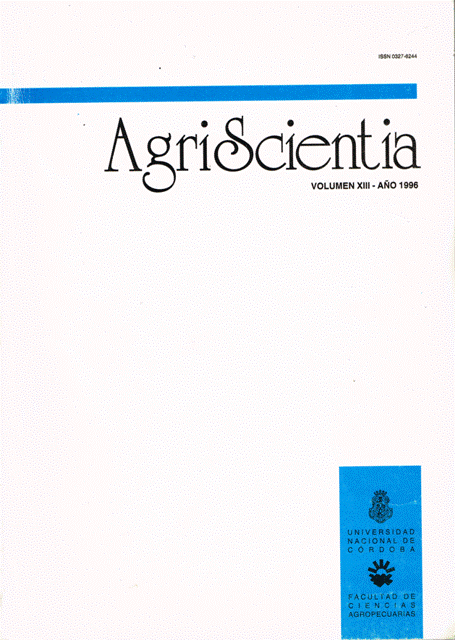Importance of host plants in the population dynamics of Nezara viridula (L.), a soybean pest.
Main Article Content
Abstract
Host plants utilized by Nezara viridula (L.) (Hemiptera: Pentatomidae), before invading soybean fields, are listed, the sequence and role of these plants is established. This work was done in the Experimental Field of the Facultad de Ciencias Agropecuarias, Universidad Nacional de Córdoba, Argentina. The sampling was done during 4 years (1990/91, 1991/92, 1992/93 and 1993/94), from September to March. The vegetable species where these bugs were more frequently found, in order of preference, belong in Fabaceae, Brassicaceae, Asteraceae, and Poaceae families. On Fabaceae, egg masses and developing nymphs were found; on Brassicaceae, Asteraceae, and Poaceae, individuals were observed feeding and copulating.
Article Details

This work is licensed under a Creative Commons Attribution-ShareAlike 4.0 International License.
How to Cite
References
Carta de Suelos de la República Argentina. (1987). Plan Mapa de suelos, Córdoba. INTA, SMAG y R.R. Fundac. Bco Provincia de Córdoba. Argentina. Hoja 3163.26. Villa del Rosario.
Jones, W.A., & Sullivan, M.J. (1982). Role of host plants in population dynamics of stink bug pests of soybean in Southern Carolina. Environmental Entomology, 11(4), 867-875.
Kiritani, K., Hokyo, N., Kimura, K., & Nakasuji, F. (1965). Imaginal dispersal of the Southern green stink bug, Nezara viridula L., in relation to feeding and oviposition. Japanese Journal of Applied Entomology and Zoology, 9(4), 291-297.
Limonti, M.R., & Villata, C.A. (1981). Control de las principales plagas en el cultivo de soja. Divulgación Técnica N°6. INTA, Manfredi, Córdoba, Argentina. 16 pp.
Panizzi, A.R., & Slansky, F., Jr. (1985a). Review of phytophagous pentatomids (Hemiptera: Pentatomidae) associated with soybean in the Americas. Florida Entomologist, 68(1), 184-214.
Panizzi, A.R., & Slansky, F., Jr. (1985b). Legume host impact on performance of adult Piezodorus guildmii (Westwood) (Hemiptera: Pentatomidae). Environmental Entomology, 14, 237-242.
Rizzo, H. (1976). Hemiptera de interés agrícola. Chinches perjudiciales y chinches benéficas para los cultivos. Ed. Hemisferio Sur, Buenos Aires. 69 pp.
Russell, E.E. (1952). Stink bugs on seed alfalfa in southern Arizona. U.S. Department of Agriculture Circular 903, 19 pp.
Thomas, G.D., Ignoffo, C.M., Morgan, C.E., & Dickerson, W.A. (1974). Southern green stink bug: Influence on yield and quality of soybeans. Journal of Economic Entomology, 67, 501-503.
Todd, J.W., & Herzog, D.C. (1980). Sampling phytophagous Pentatomidae on soybean. In M. Kogan & D.C. Herzog (Eds.), Sampling methods in soybean entomology (pp. 438-478). Springer-Verlag, New York-Heidelberg-Berlin.
Underhill, G.W. (1934). The green stink bug. Virginia Agricultural Experiment Station Bulletin, 294, 1-26.
Velasco, L.R.I., & Walter, G.H. (1992). Availability of different host plant species and changing abundance of the polyphagous bug Nezara viridula (Hemiptera: Pentatomidae). Environmental Entomology, 21(4), 751-759.
Woodside, A.M. (1947). Weed hosts of bugs which cause cat-facing of peaches in Virginia. Journal of Economic Entomology, 40, 231-233.





